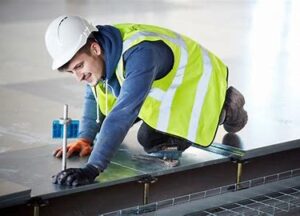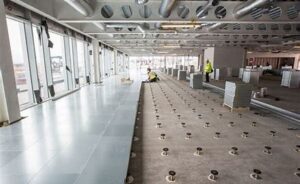Where is a Raised Access Floor Used?
A raised access floor is an innovative flooring solution designed to accommodate a range of commercial, industrial, and technological spaces. It provides flexibility for underfloor cable management, air circulation, and more, making it ideal for modern work environments such as data centers, offices, and control rooms. Where is a raised access floor used? Explore the various applications of raised access flooring and discover how it enhances operational efficiency, safety, and flexibility in diverse settings.
Where is a Raised Access Floor Used?
A raised access floor is an essential flooring system that provides a hidden void between the structural floor and the surface floor. This void serves various functional purposes, such as housing electrical wiring, HVAC systems, and data cables. But where is a raised access floor used? Raised access floors are often found in environments that require efficient cable management, air circulation, and adaptability, such as data centers, IT rooms, offices, and industrial spaces. This type of flooring helps organizations maintain a clean, organized, and safe environment, while offering versatility for quick modifications and expansions.
One of the primary applications of raised access floors is in data centers. These highly critical environments rely on efficient cooling, organized wiring, and seamless maintenance access. Raised access floors create a controlled airflow system beneath the tiles, which is essential for cooling equipment and maintaining optimal operating conditions. Moreover, the flooring allows for easy access to cables and equipment for repairs, upgrades, or reconfiguration without causing significant disruptions to the business.
Similarly, offices and corporate buildings benefit from raised access floors because they support flexible layouts and efficient use of space. As businesses grow and change, the need for more workstations, meeting rooms, or new technological infrastructures increases. Raised floors allow businesses to adapt quickly by concealing electrical wiring and data connections underneath. This results in a clutter-free, aesthetically pleasing office environment that can easily be reconfigured.
Another application for raised floors is in control rooms, particularly in industries like telecommunications, energy, and defense. These rooms often contain complex monitoring equipment that requires precise cable management and heat dissipation. A raised access floor offers the ideal solution, enabling safe and efficient routing of cables while supporting the equipment above.
Beyond commercial buildings, laboratories and pharmaceutical facilities also leverage raised floors. These sectors often demand controlled environments with strict cleanliness and safety regulations. Raised floors help create hygienic, clean spaces by hiding cables and providing a smooth, easily cleanable surface. In addition, the flooring can support heavy machinery or specialized equipment, ensuring that the facility runs efficiently without hindrance.
Where is a raised access floor used in industrial environments? Factories and manufacturing facilities benefit from raised floors as they need robust flooring solutions that can manage power lines, air ducts, and other utilities. Raised access flooring supports heavy loads while offering the ability to change layouts as machinery or production lines evolve.
In today’s digital world, many institutions are investing in smart buildings and modern educational facilities. Raised floors can be installed to handle future technological expansions, ensuring that schools, universities, and commercial spaces remain future-proof. They help integrate IT systems, interactive learning tools, and more, all while keeping cables organized and out of sight.
Overall, the versatility of raised access floors makes them suitable for a wide range of applications, from high-tech spaces to industrial environments. Their ability to provide efficient airflow, streamline cable management, and support reconfigurable spaces makes them an essential feature in modern infrastructure.
Where is a Raised Access Floor Used? Specifications Table
| Feature | Specification |
|---|---|
| Floor Height | 50mm to 1,500mm |
| Panel Size | Standard 600mm x 600mm |
| Load Capacity | 1,000 lbs to 3,000 lbs |
| Material | Galvanized steel, aluminum, and composite materials |
| Surface Finish | Anti-static, laminated, or carpeted tiles |
| Airflow Support | Perforated or gridded panels for optimal ventilation |
| Cable Management | Built-in void for power, data, and communication cables |
| Fire Resistance | Certified up to 2 hours fire rating |
| Moisture Resistance | Suitable for high-humidity environments |
| Acoustic Insulation | Noise reduction of up to 30dB |
| Accessibility | Removable panels for easy access to underfloor components |
| Weight | Lightweight but structurally robust |
| Installation Time | 5-10 square meters per day (depends on space complexity) |
| Warranty | 10-25 years depending on manufacturer |
| Environment Compatibility | Suited for both indoor and outdoor installations |
FAQs for “Where is a Raised Access Floor Used?”
- What are the main applications of raised access floors?
Raised access floors are commonly used in data centers, offices, control rooms, laboratories, and manufacturing facilities. They provide flexible cable management and enhance ventilation. - Can raised floors support heavy equipment?
Yes, raised access floors are designed to support heavy loads, with load capacities ranging from 1,000 lbs to 3,000 lbs, depending on the materials used. - Are raised floors suitable for humid environments?
Raised access floors with moisture-resistant properties can be installed in high-humidity environments, making them ideal for certain industrial or lab settings. - How do raised access floors improve cooling efficiency?
Raised floors improve cooling efficiency by allowing controlled airflow beneath the tiles. This setup is especially useful in data centers where equipment cooling is crucial. - Can raised access floors be reconfigured after installation?
Yes, one of the primary benefits of raised access floors is their flexibility. Panels can be removed and reconfigured to accommodate changes in layout or technology upgrades.
Why Choose “Where is a Raised Access Floor Used?”
Raised access floors offer numerous benefits that enhance operational efficiency and flexibility. They are perfect for environments that demand clean, organized spaces with easy access to underfloor components like electrical wiring, data cables, and HVAC systems. With features like moisture resistance, fire protection, and acoustic insulation, raised floors are adaptable to various industries, including IT, telecommunications, energy, manufacturing, and education.
Businesses that choose raised access floors benefit from future-proof infrastructures that can accommodate growth and technological changes. These floors support ergonomic designs, help reduce energy consumption through improved cooling, and streamline cable management. Choosing raised access flooring means investing in a solution that boosts productivity, safety, and space utilization.
Pros and Cons of “Where is a Raised Access Floor Used?”
| Pros | Cons |
|---|---|
| Efficient cable and airflow management | Initial installation cost can be high |
| Easy access for repairs and reconfigurations | May not be suitable for all flooring finishes |
| Supports heavy equipment and machinery | Requires periodic maintenance |
| Future-proof design adaptable to tech upgrades | Not always aesthetically pleasing without finishes |
| Fire and moisture-resistant options available | Installation time varies based on complexity |
 |
 |
